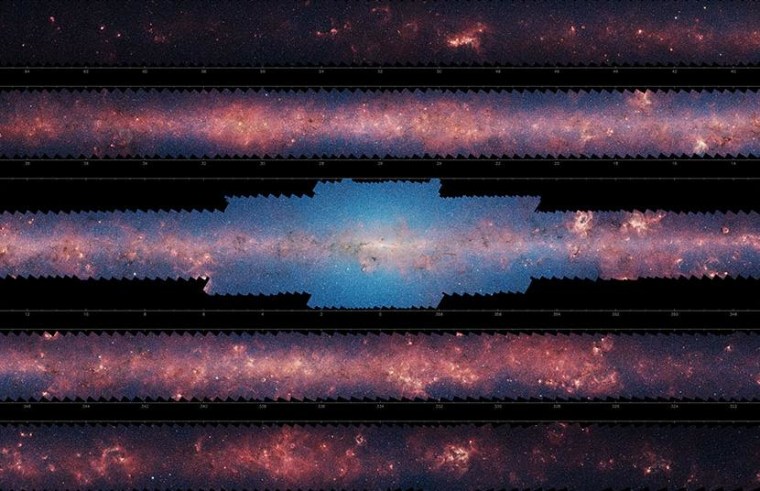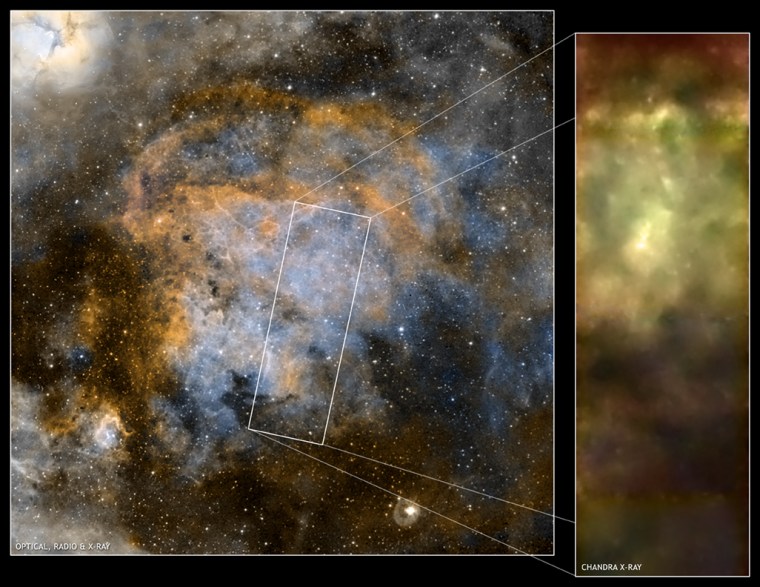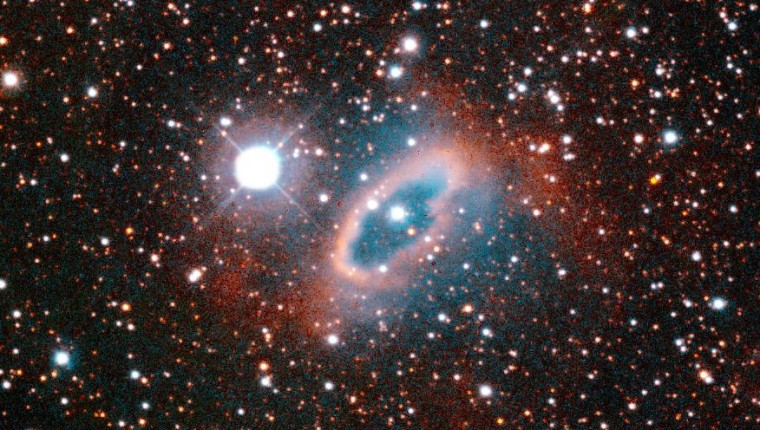The scientists behind NASA's three Great Observatories had a great opportunity to show their stuff this week at a gathering of thousands of astronomers from around the world. The good stuff included a wide shot of starbirth in our home galaxy, a second look at a supernova's leftovers, and a break in "the case of the missing dwarf."
In all three cases, the results weren't the result of one team working on its own. Observations from multiple instruments and even multiple telescopes were pooled together to create a whole that is greater than the sum of its parts.
This week's cosmic pictures serve to show what can happen when telescopes team up.
Mega-view of the Milky Way
Two teams using instruments on NASA's Spitzer Space Telescope combined their data to create an unprecedented portrait of the star-forming regions in the Milky Way. One set of infrared observations was contributed by the Galactic Legacy Infrared Mid-Plane Survey Extraordinaire team, or GLIMPSE for short. Another set came from the Multiband Imaging Photometer for Spitzer Galactic Plane Survey Legacy team, also known as MIPSGAL.
In all, more than 800,000 images were stitched together into a mosaic of the Milky Way's galactic plane that takes in 120 degrees of width and just 2 degrees of height. The portrait is so detailed, shallow and long that you have to post it on a wall - or look at it using a zoomable image browser - to get the full impact.

"This is the highest-resolution, largest, most sensitive infrared picture ever taken of our Milky Way," Sean Carey, an astronomer at NASA's Spitzer Science Center who leads the MIPSGAL team, said in a news release. "Where previous surveys saw a single source of light, we now see a cluster of stars. With this data, we can learn how massive stars form, map galactic spiral arms and make a better estimate of our galaxy's star formation rate."
Spitzer's infrared sight is particularly good at seeing through the dust that shrouds newborn stars. Stellar nurseries show up as swaths of green, with young stars (looking like yellow and red dots) carving away bubbles in the dust. The wisps of red that fill most bubbles are composed of graphite dust particles. Older stars show up as blue specks, and the dusty remnants of dying and dead stars look like translucent orange spheres.
The detailed imagery shows that our galaxy is crowded with stars, many of which don't show up in visible wavelengths. "With these Spitzer data, we've been able to catalog more than 100 million stars," said Edward Churchwell, an astronomer at the University of Wisconsin at Madison who is the principal investigator for the GLIMPSE team.
Second look at a supernova's leftovers
While Spitzer leans toward the long-wavelength side of the electromagnetic spectrum, the Chandra X-ray Observatory focuses on short-wavelength X-rays. Chandra is thus most suited to spot high-energy phenomena, such as the effects of black holes and exploding stars.

Chandra's image of the week is a closer look at a supernova remnant known as W28. The latest imagery focuses on the shape and extent of the high-energy emissions at W28's very center. That view can be combined with imagery documenting the scene in other wavelengths. Radio emissions were mapped by the Very Large Array in New Mexico, the optical-wavelength view came from the Cerro Tololo Inter-American Observatory in Chile, and earlier X-ray imagery was provided by the international ROSAT satellte.
The result is a complex picture that blends together characteristics from various standard types of supernova remnants. Each wavelength provides more information about how the supernova shock wave is interacting with the cloudy environment surrounding W28's parent star.
"By studying W28 and others like it, astronomers hope to better understand the complexities involved when a star explodes in a crowded neighborhood," the Chandra team said in this week's image advisory.
The case of the missing dwarf
The third and best-known of the Great Observatories is the Hubble Space Telescope, but in this case, it was the Hubble team rather than the telescope itself that made the key contribution.
At this week's meeting of the American Astronomical Society in St. Louis, Katrina Exter and Howard Bond of the Space Telescope Science Institute proposed a solution to a mystery surrounding the planetary nebula SuWt 2. The gaseous ring of stellar gas glows about 6,500 light-years from Earth in the constellation Centaurus.
Slideshow 12 photos
Month in Space: January 2014
What set the ring aglow? The usual suspect would be a star that puffed up and blew away all that gas, then shrank into a white dwarf. But no such dwarf has ever been detected, either in the imagery from ground-based telescopes or in data from NASA's International Ultraviolet Explorer satellite. Instead, astronomers have focused on two suspicious-looking binary stars whirling around each other every five days. Neither star is a white dwarf - in fact, they're hotter than our sun, although not hot enough to light up the nebula's ring of gas.
In their effort to solve the mystery, Exter, Bond and their colleagues conducted a stake-out on the two stars, using ground-based observations from the Cerro Tololo observatory, the New Technology Telescope at the European Southern Observatory in Chile, the Anglo-Australian Telescope in Australia and the South African Astronomical Observatory.
The stars turned out to be larger than would have been expected for their masses, and they're also rotating more slowly than expected. That suggests that the stars are on their way to becoming red giants - and thus wouldn't be responsible for creating the ring.
So what's the solution? The astronomers suggest that a third star, orbiting farther out, became a red giant and puffed up to engulf the two stars we see today. That could have caused a downward spiral that spun up the whole system, causing the red giant's envelope of gas to whirl away and create the glowing ring.
"If the giant's core were of high enough mass, it would then shrink and cool off rapidly to a faint white dwarf, which might explain its current invisibility," the Hubble team reported in a news release about the findings.
So the case of the missing dwarf isn't exactly closed - but thanks to Exter, Bond and their colleagues, there's a new prime suspect in the mystery.
For more mysteries and marvels, check out our latest "Month in Space" roundup of cosmic imagery, as well as the other gems in our Space Gallery.
To get the full lineups for the Spitzer teams, check out the and Web sites. The team behind the Chandra W28 study includes Jonathan Keohane (Hampden-Sydney College), Jeonghee Rho (Spitzer Science Center), Thomas Pannuti (Morehead State University), Kazik Borkowski (North Carolina State University) and Frank Winkler (Middlebury College). The SuWt 2 research team includes Exter and Bond (Space Telescope Science Institute) as well as Keivan Stassun (Vanderbilt University), Pierre Maxted and Barry Smalley (Keele University) and Don Pollacco (Queen's University).
A version of this report originally appeared as a Cosmic Log posting.

